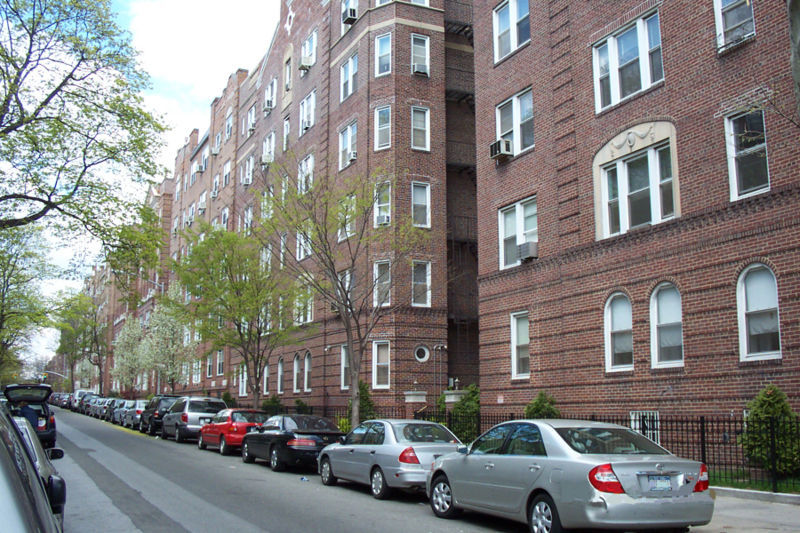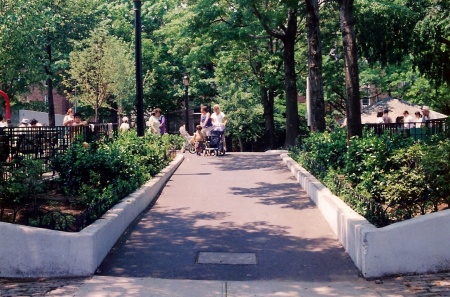|
|
Into Modern Day
From The Peopling of New York City
Dynamic 1940s
MacDougall died in September of 1944- just at the time when all the pent-up construction demands from the war were building up and about to explode [3]. In a sense, with MacDougall died his Utopian dream, and even though his very motivated and able son took over the company [4], he did not share his father's vision. The post-war construction boom also brought outside developers [5], in place of the ones who built the original Garden complexes, and in the midst the high housing demands the Queensboro company introduced dozens of new building complexes, both rentals and cooperatives, however, this rapid development came at the expense of all the open space and garden facilities MacDougall had in mind for his community [6]. 38 new apartment buildings went up in 1950 alone, but at the same time the gardens that once made 80th street and the neighborhood special and unique were removed, the "wave of construction obliterated many end-block gardens along 35th and 34th Avenues. By 1954 virtually every plot of ground had been used for residential construction." [7] . The once advertised playgrounds, tennis courts and of course the golf course were all replaced by large apartment complexes [8] and the garden community seemed to be gone forever. Nevertheless, the vigilant Jackson Heights residents took notice of their depleting facilities, and the Jackson Heights Community Federation became active in the late 1940s, lobbying for what they considered causes vital to "the quality of life in the community" [9]. They called for a construction of a park between 77th and 78th Streets, from 34th Avenue to Northern Boulevard, now called Travers Park- a few blocks from the residents on 80th street, a Junior High School, I.S. 145- which was built over the old tennis courts, and a library on 81st and 37th Avenue [10]. Unfortunately the large community complex campus they requested was not granted [11]. During this time many young families came into 80th Street and Jackson Heights again, similar to habituation patterns 30 years ago [12]; however, this time it was a slightly different, because with the Garden Community ideal vision, also died the bias against non-white middle-class families.
The New Face of Jackson Heights
Although it still felt like the small-town it once was [13], by 1960 Jackson Heights was no longer a self-contained model community- the residents of the Towers and Greystone complexes were now part of an international community, especially with the relaxation of United States immigration policy beginning at this time [14]. In fact, so many new immigrants flocked to Jackson Heights, that it became known as the "Ellis Island of the 20th Century" [15]. The people who starting living in the apartment complexes on 80th Street began to transform. In addition to the arrival of thousands of new foreigners, the development of a new highway system introduced by powerful city planner Robert Moses [16] helped promote the "white flight" or the migration of the older, white, residents east to Nassau County suburbs [17], leaving Jackson Heights to be filled by incoming immigrants. These 11,400 newcomers included Colombians (who made up the largest group), Chinese, Dominicans, Asian Indians, Ecuadoreans, Koreans, Guyanese, Peruvians, Cubans, and Pakistanis [18]. Jews who were excluded before, started moving in to the area as well, however, most of the new residents were from Latin America and Asia; the non-Hispanic white population of Jackson Heights went from 67% in 1970 to just 28% by 1990[19] , clearly, this was not MacDougall's model community anymore. In fact, by the 1970s, 80th street faced tough economic times due to New York City's fiscal crisis and inflation, causing interest rates to reach a high of 20% [20]. One result of this rapid inflation was the gigantic rent increase which lead to the conversion of rentals back into cooperatives in large proportions - at least 60 buildings were converted in Jackson Heights alone by 1980, including the Towers, adding 5000 new co-ops to the already existing 5000. [21].
 Jackson Heights Today Jackson Heights Today
80th Street Today
With the return of the Cooperative Apartments, and the return to a stable economy by the 1980s, things looked good for 80th street and its future. In addition, the community began to look back on its past and embrace its Garden Community beginnings- MacDougall's vision was still present after decades of absence. In 1988, with its diverse population, and established neighborhood, a resident named Mike Crowley sought out to revive the "spirit" of Jackson Heights and founded the Jackson Heights Beautification Group (JHBG) [22], reigniting the community spirit of the town and a collective drive to improve the quality of life, as MacDougall set out to do 70 years earlier. The JHBG's biggest victory was finally winning recognition of Jackson Heights as an Historical District in 1993 [23]. After years of petitioning, JHBG succeeded in getting The Landmarks Preservation Commission to vote to designate 36 blocks of Jackson Heights as an historical distinct [24], making it only the second district in Queens [25]. The core of this marked of region includes 34th to 37th Avenues and 77th to 88th streets- mostly side streets and includes most of the originally Garden Apartments preserved in their initial grandeur [26]. The designation as historical district was the start of a new era in Jackson Heights, one returning to some of the ideals of its creator- a community of comfortable, spacious apartments in the midst of an urban environment.
Starting out as just a piece of farmland, 80th Street in Jackson Heights today is a fully developed neighborhood, populated with a diverse group of largely foreign-born, middle-to-upper class city workers [27]. Though rental of these apartments is around $1000 a month, sales approach $698,000- which is currently the going price for a Greystone apartment [28]. A stroll down the neighborhood will reveal various sounds and flavors of Indian, Jewish, Korean, Polish, Irish, Chinese, Russian and South American variety [29]. What started out as an exclusively white community is now known as one of most diverse communities in the country, and continues to be a magnet for people of all different backgrounds [30]. Its opening atmosphere and acceptance has also made the neighborhood one of New York City's most prominent gay and lesbian communities outside of Manhattan [31]. Most importantly, staying true to its roots, Jackson Heights still contains the most private parks or gardens than any other United States community [32]- MacDougall's vision seemed to have been fulfilled after all. Though not a Utopia, the new Jackson Heights displays diverse richness, with a strong sense of community, comfort and of course a love for gardens. Put perfect by Jeffrey Saunders, the president of the Jackson Heights City Garden Society, ""People move to Jackson Heights because they want a sense of urbanity - all-night grocery stores for example - while also having lots of street trees and gardens. This is a place that is recognizable and comfortable for transplants from Manhattan and Brooklyn, but maintains a strong residential vibe." [33] .
Main Page
Discovering 80th Street and the Community Around it
User:Eraparia
Notes
- ↑ Vladimir Simkhovich
- ↑ John Roleke, "Jackson Heights- Queens Neighborhood Profiles," June 2005, http://queens.about.com/od/neighborhoods/p/jacksonheights.htm (accessed April 1, 2009).
- ↑ David Watson, “Jackson Heights Beautification Group,” History of Jackson Heights, Jackson Heights Beautification Group, 2009, http://www.jhbg.org/history/history.html (accessed April 1, 2009)
- ↑ Daniel Karatzas,Jackson Heights: A Garden in the City," (New York: Jackson Heights Beautification Group, 1998), 175
- ↑ Rhoda Amon, "Jackson Heights: Pioneering in New Types of Housing," The Morning Call, 2009, at http://www.mcall.com/topic/ny-historytown-hist000i,0,1758083.story
- ↑ David Watson, “Jackson Heights Beautification Group,” History of Jackson Heights, Jackson Heights Beautification Group, 2009, http://www.jhbg.org/history/history.html (accessed April 1, 2009)
- ↑ Daniel Karatzas, "Jackson Heights: A Garden in the City," (New York: Jackson Heights Beautification Group, 1998), 188.
- ↑ Rhoda Amon, "Jackson Heights:Pioneering in New Types of Housing," The Morning Call, 2009, at http://www.mcall.com/topic/ny-historytown-hist000i,0,1758083.story
- ↑ Daniel Karatzas, 197
- ↑ Daniel Karatzas, 201
- ↑ Daniel Karatzas, 201
- ↑ David Watson, “Jackson Heights Beautification Group,” History of Jackson Heights, Jackson Heights Beautification Group, 2009, http://www.jhbg.org/history/history.html (accessed April 1, 2009)
- ↑ Daniel Karatzas, 210
- ↑ Erin Bradley, "Jackson Heights," The Cooperator, March 2006, at http://www.cooperator.com/articles/1261/1/Jackson-Heights/Page1.html
- ↑ Erin Bradley, "Jackson Heights," The Cooperator, March 2006, at http://www.cooperator.com/articles/1261/1/Jackson-Heights/Page1.html
- ↑ Erin Bradley, "Jackson Heights," The Cooperator, March 2006, at http://www.cooperator.com/articles/1261/1/Jackson-Heights/Page1.html
- ↑ Rhoda Amon, "Jackson Heights: Pioneering in New Types of Housing," The Morning Call, 2009, at http://www.mcall.com/topic/ny-historytown-hist000i,0,1758083.story
- ↑ Rhoda Amon, "Jackson Heights: Pioneering in New Types of Housing," The Morning Call, 2009, at http://www.mcall.com/topic/ny-historytown-hist000i,0,1758083.story
- ↑ Nancy Foner, "From Ellis Island to JFK," (New Haven: Yale University Press, 2000), 85.
- ↑ David Watson, “Jackson Heights Beautification Group,” History of Jackson Heights, Jackson Heights Beautification Group, 2009, http://www.jhbg.org/history/history.html (accessed April 1, 2009)
- ↑ David Watson, “Jackson Heights Beautification Group,” History of Jackson Heights, Jackson Heights Beautification Group, 2009, http://www.jhbg.org/history/history.html (accessed April 1, 2009)
- ↑ Rhoda Amon, "Jackson Heights: Pioneering in New Types of Housing," The Morning Call, 2009, at http://www.mcall.com/topic/ny-historytown-hist000i,0,1758083.story
- ↑ Daniel Karatzas, 220
- ↑ Daniel Karatzas, 221
- ↑ Rhoda Amon, "Jackson Heights: Pioneering in New Types of Housing," The Morning Call, 2009, at http://www.mcall.com/topic/ny-historytown-hist000i,0,1758083.story
- ↑ Myra Alperson, "Nosh New York," (New York: Macmillan, 2003), 43.
- ↑ Erin Bradley, "Jackson Heights," The Cooperator, March 2006, at http://www.cooperator.com/articles/1261/1/Jackson-Heights/Page1.html
- ↑ "Real Estate," New York Times, http://realestate.nytimes.com/sales/detail/56-607926/80TH-STREET-Queens-NY-11372 (accessed May 10, 2009).
- ↑ Erin Bradley, "Jackson Heights," The Cooperator, March 2006, at http://www.cooperator.com/articles/1261/1/Jackson-Heights/Page1.html
- ↑ Daniel Karatzas, 229
- ↑ Erin Bradley, "Jackson Heights," The Cooperator, March 2006, at http://www.cooperator.com/articles/1261/1/Jackson-Heights/Page1.html
- ↑ Erin Bradley, "Jackson Heights," The Cooperator, March 2006, at http://www.cooperator.com/articles/1261/1/Jackson-Heights/Page1.html
- ↑ Julie Satow,"The Secret is Out on the Gardens of Jackson Heights," New York Sun, May 5, 2005, at http://www.nysun.com/real-estate/secret-is-out-on-the-gardens-of-jackson-heights/13361/
|



